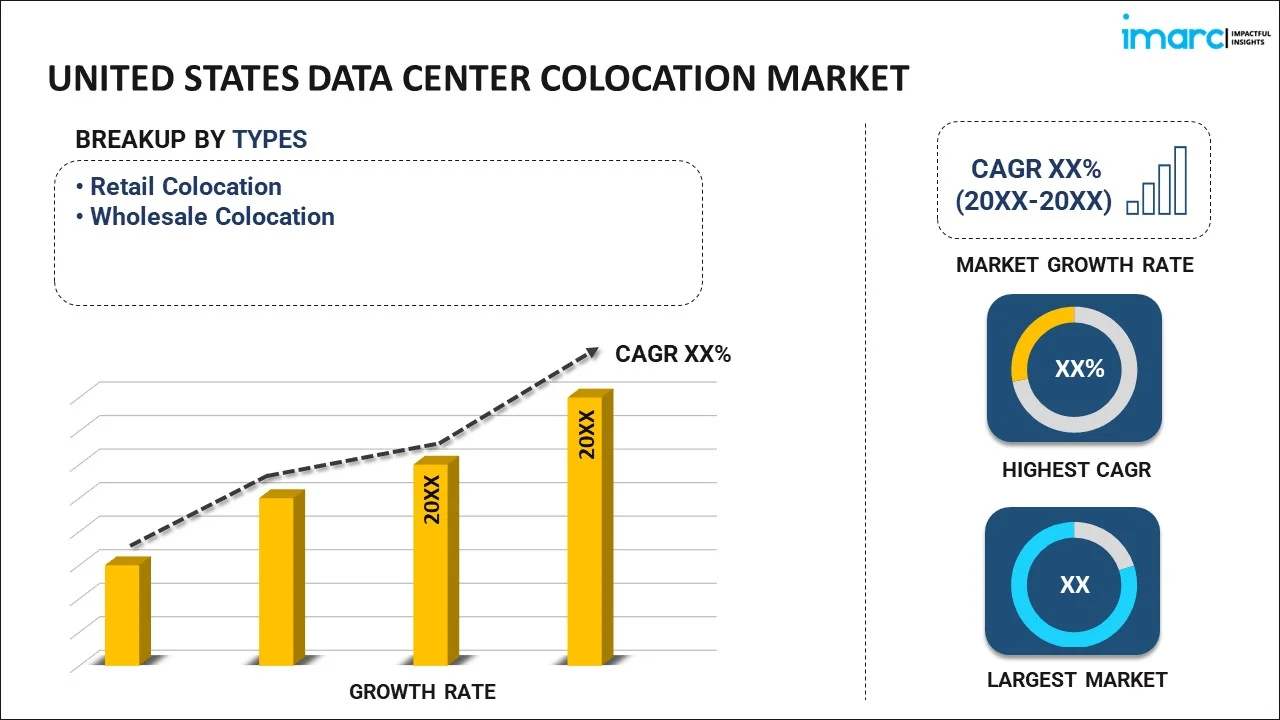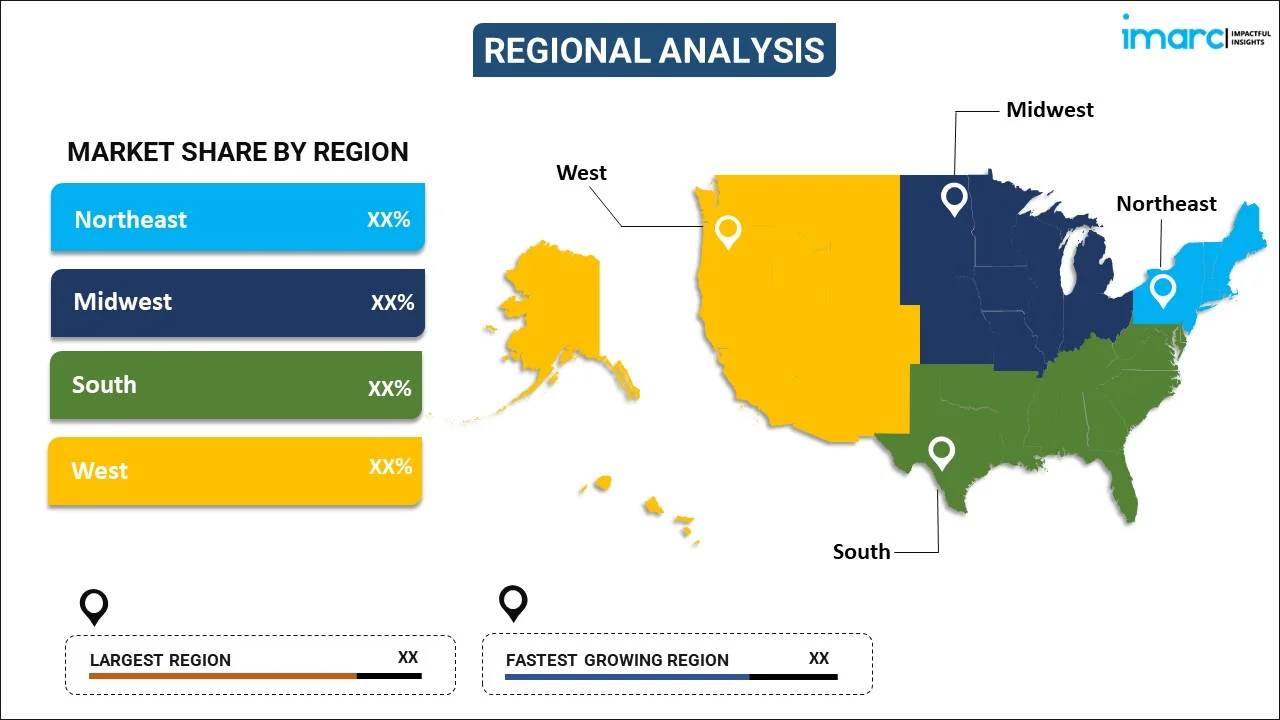
United States Data Center Colocation Market Report by Type (Retail Colocation, Wholesale Colocation), Organization Size (Small and Medium-sized Enterprises, Large Enterprises), End Use Industry (BFSI, Manufacturing, IT and Telecom, Energy, Healthcare, Government, Retail, Education, Entertainment and Media, and Others), and Region 2025-2033
Market Overview:
United States data center colocation market size reached USD 13.9 Billion in 2024. Looking forward, IMARC Group expects the market to reach USD 25.2 Billion by 2033, exhibiting a growth rate (CAGR) of 6.8% during 2025-2033. The inflating need for providing a flexible solution that can adapt to the evolving needs of businesses in an ever-changing technological landscape is primarily driving the market growth across the country.
|
Report Attribute
|
Key Statistics
|
|---|---|
|
Base Year
|
2024 |
|
Forecast Years
|
2025-2033 |
|
Historical Years
|
2019-2024
|
| Market Size in 2024 | USD 13.9 Billion |
| Market Forecast in 2033 | USD 25.2 Billion |
| Market Growth Rate (2025-2033) | 6.8% |
United States Data Center Colocation Market Insights:
- Major Market Drivers: United States data center colocation market growth is largely influenced by growing cloud adoption, data consumption growth, and need for scalable IT infrastructure to allow companies to curb capital expenditure and enhance operational efficiency through shared facility environments.
- Market Trends: One of the major trends that will mold the market is the increasing adoption of hybrid and multi-cloud environments within colocation facilities, allowing businesses to have high-speed connectivity, workload agility, and public cloud on-ramps in various geographic locations.
- Competitive Landscape: The market is defined by infrastructure investments, geographic expansion, and service expansion, as colocation players vie on reliability, low-latency interconnects, and sustainable operations to serve increasing enterprise demand in finance, healthcare, retail, and digital services.
- Challenges and Opportunities: Although energy and regulatory compliance are challenges, opportunities arise in edge deployment, green energy solutions, and AI-ready infrastructure, setting the stage for colocation players to serve enterprise digitalization and new low-latency computing needs.
United States Data Center Colocation Market Trends:
Rising Power and Cooling Efficiency Optimization
As data consumption is growing faster across industries, United States colocation providers are putting more efforts into increasing power and cooling efficiency to address changing enterprise requirements. Advanced technologies including liquid cooling systems, artificial intelligence-based temperature control, and modular cooling infrastructure are being utilized to enhance effectiveness in energy consumption (EUE). These solutions not only ensure the best performance of hardware but are also in line with the increasing sustainability objective. Further, state-level policies that promote efficient energy usage are strengthening this trend. Efficient cooling systems are critical in high-density computing environments such as AI and hyperscale workloads, where all traditional cooling mechanisms do not deliver. This focus on efficiency is driving a measurable shift in operational benchmarks across facilities. Consequently, United States data center colocation market share is also increasing since customers want sustainable solutions with strong infrastructure that ensures optimum utilization of energy and minimal loss of electricity in colocation sites.
Hybrid and Multi-Cloud Integration Strategies
Hybrid and multi-cloud computing strategies have emerged as a hallmark trend for the colocation industry in the United States. Businesses are increasingly running mission-critical applications in multiple environments—on-premise, public cloud, and private cloud—requiring the use of colocation services that facilitate smooth integration. Colocation businesses are providing connectivity-rich environments with proximity to key cloud on-ramps and internet exchanges, facilitating workload distribution and latency-reduced communication. These hybrid environments offer flexibility, security, and performance benefits, making it possible for organizations to scale resources on demand. This strategic action also enables companies to preserve control of sensitive workloads while tapping cloud scalability on less-critical workloads. Increasing complexity in IT architectures is therefore supporting United States data center colocation market analysis, where colocation serves as a central location for hybrid and cloud-native deployments, further solidifying its position in contemporary enterprise infrastructure models within financial services, retail, healthcare, and technology industries.
Edge Deployment and Regional Expansion
To accommodate growing demand for low-latency applications like autonomous systems, video streaming, and the Internet of Things, data center colocation facilities are expanding their footprints to edge locations throughout the United States. This expansion involves smaller, strategically positioned facilities near end users, allowing for quicker data processing and lower latency. With growing digital transformation, edge colocation demand is becoming increasingly evident in secondary and underserved cities, enabling localized computing demands and regional business activity. These are generally small-scale deployments that are linked with central colocation centers, forming a distributed topology that enhances scalability and redundancy. United States data center colocation market demand keeps rising, driven by 5G deployment, smart infrastructure, and immersive digital services. This transition is serving as a major driver for redefining national infrastructure priorities, setting up colocation not only as a centralized solution but also as an enabler of real-time data experiences and decentralized digital ecosystems.
United States Data Center Colocation Market Segmentation:
IMARC Group provides an analysis of the key trends in each segment of the market, along with forecasts at the country level for 2025-2033. Our report has categorized the market based on type, organization size, and end use industry.
Type Insights:

To get more information on this market, Request Sample
- Retail Colocation
- Wholesale Colocation
The report has provided a detailed breakup and analysis of the market based on the type. This includes retail colocation and wholesale colocation.
Organization Size Insights:
- Small and Medium-sized Enterprises
- Large Enterprises
A detailed breakup and analysis of the market based on the organization size have also been provided in the report. This includes small and medium-sized enterprises and large enterprises.
End Use Industry Insights:
- BFSI
- Manufacturing
- IT and Telecom
- Energy
- Healthcare
- Government
- Retail
- Education
- Entertainment and Media
- Others
The report has provided a detailed breakup and analysis of the market based on the end use industry. This includes BFSI, manufacturing, IT and telecom, energy, healthcare, government, retail, education, entertainment and media, and others.
Regional Insights:

- Northeast
- Midwest
- South
- West
The report has also provided a comprehensive analysis of all the major regional markets, which include the Northeast, Midwest, South, and West.
Competitive Landscape:
The market research report has also provided a comprehensive analysis of the competitive landscape in the market. Competitive analysis such as market structure, key player positioning, top winning strategies, competitive dashboard, and company evaluation quadrant has been covered in the report. Also, detailed profiles of all major companies have been provided.
Latest News and Developments:
- In July 2025, a \\$440 million Bastrop County, Texas, colocation data center project was launched. As the first phase of a \\$1.44 billion multi-building complex, the facility will serve to host growing enterprise and AI infrastructure as it meets the accelerating demand for advanced digital capabilities throughout the United States.
- In July 2025, Nebius unveiled a phased 300MW New Jersey data center development and solidified a colocation deployment in Keflavik, Iceland via Switch. The Icelandic facility, fueled by geothermal power, and the Kansas City expansion are due online by Q2 2025 and will support Nebius' year-end 100MW installed capacity objective.
United States Data Center Colocation Market Report Coverage:
| Report Features | Details |
|---|---|
| Base Year of the Analysis | 2024 |
| Historical Period | 2019-2024 |
| Forecast Period | 2025-2033 |
| Units | Billion USD |
| Scope of the Report | Exploration of Historical and Forecast Trends, Industry Catalysts and Challenges, Segment-Wise Historical and Predictive Market Assessment:
|
| Types Covered | Retail Colocation, Wholesale Colocation |
| Organization Sizes Covered | Small and Medium-sized Enterprises, Large Enterprises |
| End Use Industries Covered | BFSI, Manufacturing, IT and Telecom, Energy, Healthcare, Government, Retail, Education, Entertainment and Media, Others |
| Regions Covered | Northeast, Midwest, South, West |
| Customization Scope | 10% Free Customization |
| Post-Sale Analyst Support | 10-12 Weeks |
| Delivery Format | PDF and Excel through Email (We can also provide the editable version of the report in PPT/Word format on special request) |
Key Benefits for Stakeholders:
- IMARC’s industry report offers a comprehensive quantitative analysis of various market segments, historical and current market trends, market forecasts, and dynamics of the United States data center colocation market from 2019-2033.
- The research report provides the latest information on the market drivers, challenges, and opportunities in the United States data center colocation market.
- Porter's five forces analysis assist stakeholders in assessing the impact of new entrants, competitive rivalry, supplier power, buyer power, and the threat of substitution. It helps stakeholders to analyze the level of competition within the United States data center colocation industry and its attractiveness.
- Competitive landscape allows stakeholders to understand their competitive environment and provides an insight into the current positions of key players in the market.
Key Questions Answered in This Report
The data center colocation market in the United States was valued at USD 13.9 Billion in 2024.
The United States data center colocation market is projected to exhibit a (CAGR) of 6.8% during 2025-2033, reaching a value of USD 25.2 Billion by 2033.
The key drivers of the market are the exponential rise in data volumes, growing use of cloud services, and the necessity for cost-efficient, scalable infrastructure. Businesses require better network connectivity, data protection, and disaster recovery. Furthermore, growing demand for edge computing and hybrid cloud integration is driving the deployment of colocation across many industry segments.
Need more help?
- Speak to our experienced analysts for insights on the current market scenarios.
- Include additional segments and countries to customize the report as per your requirement.
- Gain an unparalleled competitive advantage in your domain by understanding how to utilize the report and positively impacting your operations and revenue.
- For further assistance, please connect with our analysts.
 Request Customization
Request Customization
 Speak to an Analyst
Speak to an Analyst
 Request Brochure
Request Brochure
 Inquire Before Buying
Inquire Before Buying




.webp)




.webp)












